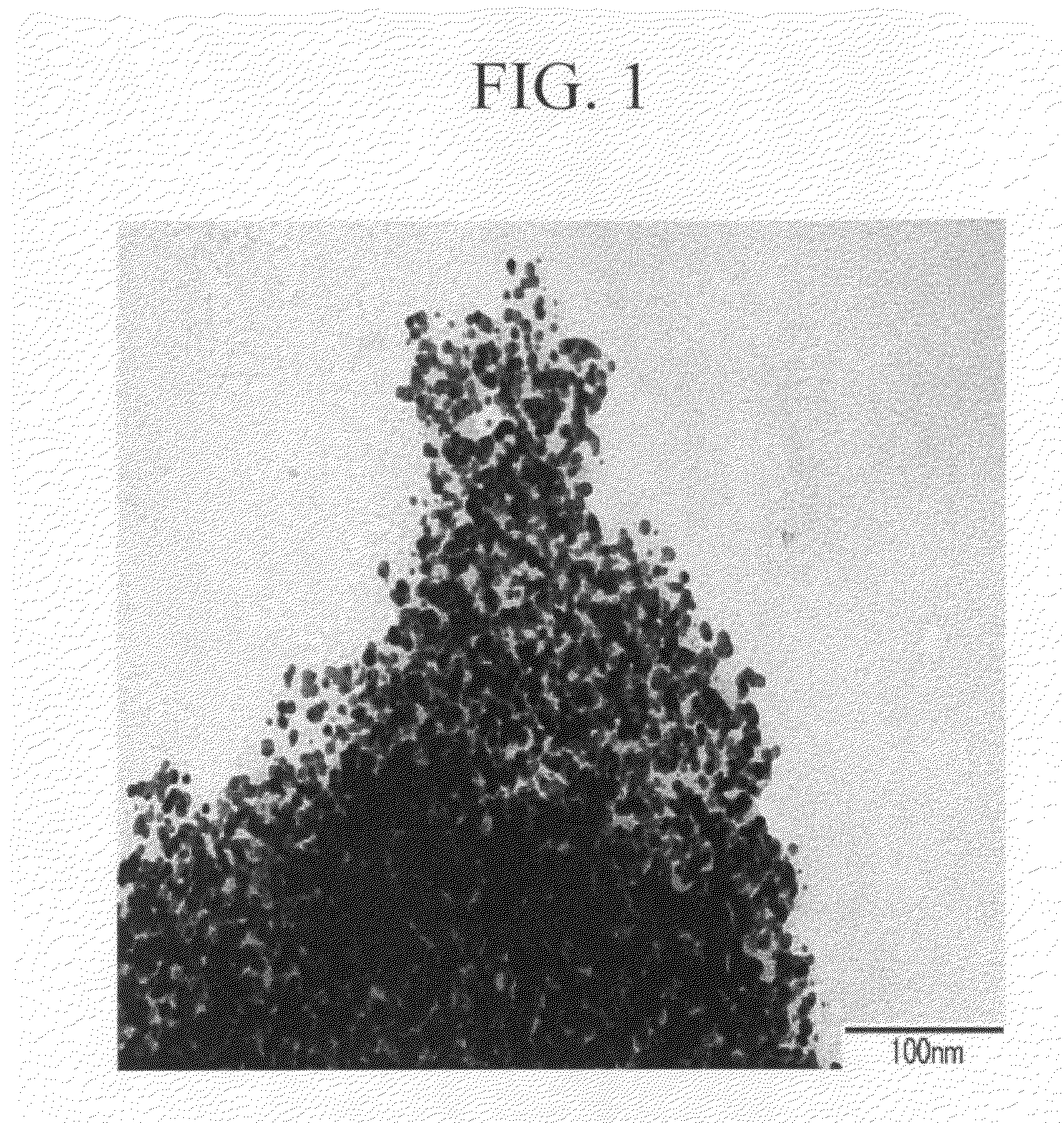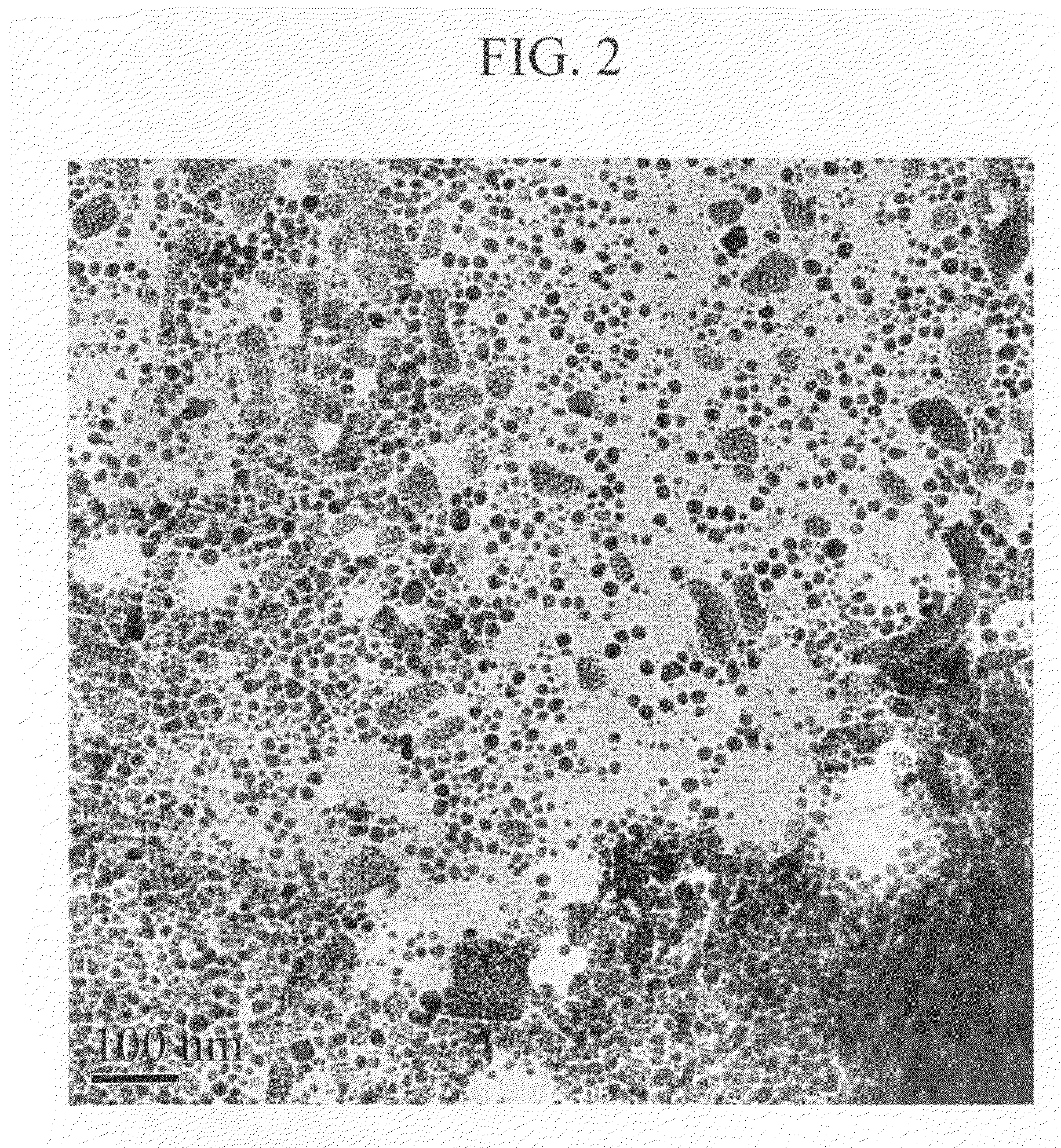Metal nanoparticle dispersion and production process of the same
a technology of metal nanoparticles and production processes, applied in the direction of basic electric elements, non-conductive materials with dispersed conductive materials, conductors, etc., can solve the problems of poor storage stability, preventants in the form of water-soluble polymers from providing radical solutions for storage stability, and protectants that are susceptible to cohesion, etc., to achieve stable dispersed state, easy adjustment, and superior self-assembling ability
- Summary
- Abstract
- Description
- Claims
- Application Information
AI Technical Summary
Benefits of technology
Problems solved by technology
Method used
Image
Examples
synthesis example 1
Synthesis of Polymer Compound (X-1) Having PEG-Linear PEI-PBEI Structure
[0123]1-1 [Tosylation of Polyethylene Glycol]
[0124]A solution in which 4.9 g (25.5 mmol) of tosyl chloride were dissolved in 15 g of chloroform was added to a solution wherein a mixture of 10 g (5.1 mmol) of PEGM (number average molecular weight (Mn): 2000), 15 g of chloroform and 4 g (51 mmol) of pyridine were mixed followed by allowing to react for 4 hours at 40° C. Following completion of the reaction, the reaction solution was diluted by adding 30 g of chloroform followed by washing twice with 300 g of 2.5 mol / L hydrochloric acid, twice with 300 g of 10% aqueous sodium hydrogen carbonate solution and twice with 300 g of water. The resulting chloroform solution was dried using sodium sulfate followed by filtering and concentrating with an evaporator. This was then added to hexane while stirring to precipitate followed by vacuum-drying. The yield was 81%. As a result of assigning the peaks of the 1H-NMR spectr...
synthesis example 2
Synthesis of Polymer Compound (X-2) Having PEG-PEI-BisAEP Structure
[0134]2-1 [Tosylation of EP]
[0135]A solution in which 7.5 g (39.5 mmol) of tosyl chloride were dissolved in 15 g of chloroform was added to a solution wherein 2 g of bisphenol A epoxy resin (DIC Corp., EPICLON AM-040-P, epoxy groups: 7.9 mmol), 10 g of chloroform and 6.2 g (79 mmol) of pyridine were mixed followed by allowing to react for 4 hours at 40° C. Following completion of the reaction, the reaction solution was diluted by adding 20 g of chloroform followed by washing twice with 100 g of 2.5 mol / L hydrochloric acid, twice with 100 g of 10% aqueous sodium hydrogen carbonate solution and twice with 100 g of water. The resulting chloroform solution was dried using sodium sulfate followed by filtering and concentrating with an evaporator. This was then added to hexane to precipitate followed by vacuum-drying. The yield was 91%. As a result of assigning the peaks of the 1H-NMR spectrum (1.6 ppm: methyl group of Bis...
synthesis example 3
Synthesis of Polymer Compound (X-3) Having PPEI-Linear PEI-BisAEP Structure
[0144]3-1 [Tosylation of EP] BisAEP-Ts was obtained in the same manner as Synthesis Example 2-1.
[0145]3-2 [Living Cationic Polymerization of MOZ and EOZ]
[0146]0.30 g (tosyl group: 0.71 mmol) of the BisAEP-Ts obtained above were mixed with 3 ml (34 mmol) of MOZ and 30 ml of DMA in a nitrogen atmosphere and sealed followed by allowing to react for 86 hours at 100° C. After cooling, 4.7 g (34 mmol) of EOZ were added and sealed followed by stirring for 91 hours at 100° C. The resulting reaction solution was added to a mixed solvent of 150 g of ethyl acetate and 150 g of hexane to precipitate. After decanting, the obtained precipitate was dissolved in 10 g of methanol and re-precipitated by adding to a mixed solvent of 150 g of ethyl acetate and 150 g of hexane. The precipitate was then filtered and vacuum-dried at 80° C. The yield was 94%.
[0147]As a result of assigning the peaks of the 1H-NMR spectrum (1.1 ppm: m...
PUM
| Property | Measurement | Unit |
|---|---|---|
| Particle diameter | aaaaa | aaaaa |
| Dispersion potential | aaaaa | aaaaa |
| Hydrophilicity | aaaaa | aaaaa |
Abstract
Description
Claims
Application Information
 Login to View More
Login to View More - R&D
- Intellectual Property
- Life Sciences
- Materials
- Tech Scout
- Unparalleled Data Quality
- Higher Quality Content
- 60% Fewer Hallucinations
Browse by: Latest US Patents, China's latest patents, Technical Efficacy Thesaurus, Application Domain, Technology Topic, Popular Technical Reports.
© 2025 PatSnap. All rights reserved.Legal|Privacy policy|Modern Slavery Act Transparency Statement|Sitemap|About US| Contact US: help@patsnap.com


